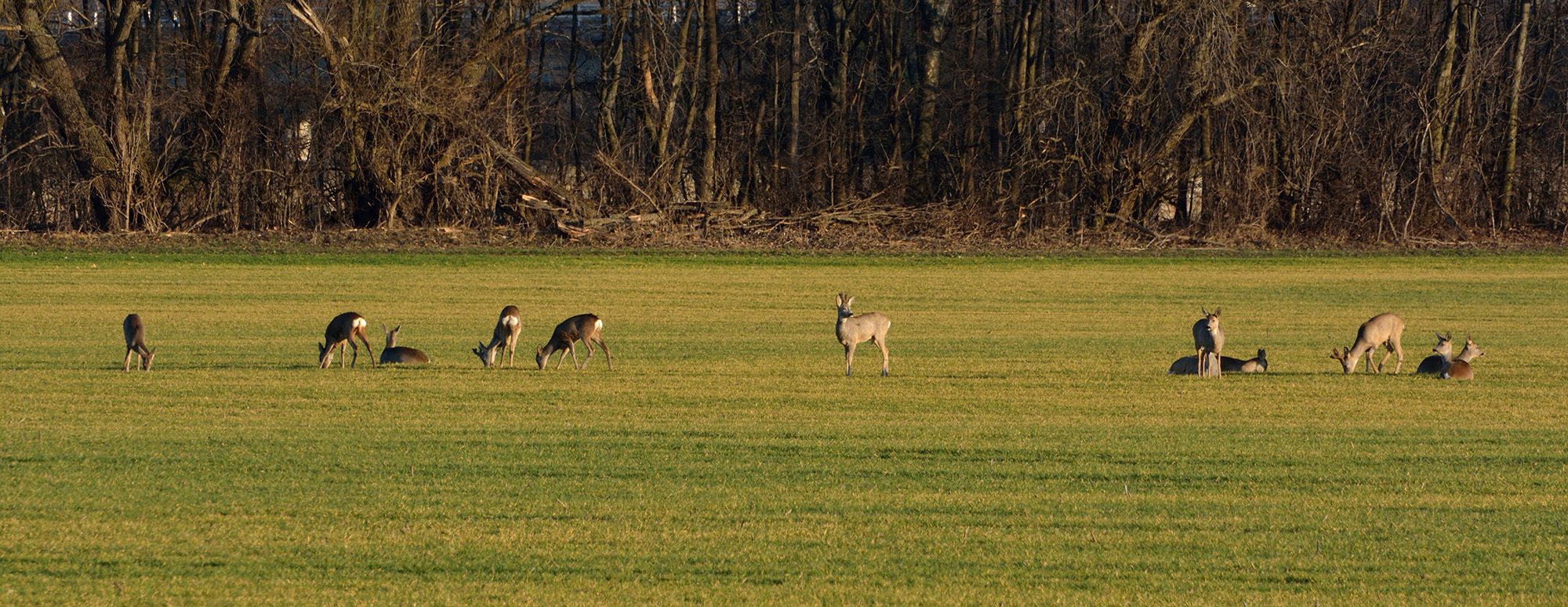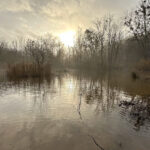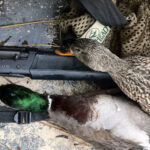Choosing the right food plots for deer is not merely a task but an art. Both hunters and deer stand to benefit significantly from well-executed food plots. Not only do they serve as a magnet to attract deer, but they also help to improve the overall health and vitality of the deer population.
However, successful food plotting isn’t as simple as scattering seeds and hoping for the best. Many factors influence the effectiveness of a food plot, including the time of the year, geographical location, and deer habits.
We’ve conducted thorough research and gathered data-driven insights to guide you in choosing the best food plots for deer. Through our research, we’ve identified the top food plots for each season and region.
Whether you’re aiming for a perfect archery season trophy or working on land management, rediscover the joy of deer hunting with our specialized recommendations. Join us as we journey through the tips, tricks, and top recommendations for deer food plots.
The header photo credit is courtesy of PEZI on Wikipedia.
The Importance of Choosing the Right Seed
Deer seeds play a significant role in the wildlife management and hunting experience. Ensuring you pick the right seed for your food plot is as crucial as placing a treestand in the right spot.
Choosing your seed thoughtlessly can lead to a less productive hunting season. The right food plot seed attracts, nourishes, and keeps deer on your land, increasing your hunting yield.
Imagine spending time on a brassica combination only to find out it was not the right fit for your area. By carefully selecting your seed, you maximize your odds of success.
How Food Plots Contribute to Deer Health
Food plots significantly contribute to deer health, particularly in areas where natural food sources are limited.
Deer require a balanced diet of proteins, carbohydrates, and essential minerals to maintain optimum health, reproduce successfully and grow large antlers. Through the careful selection of food plot seeds, deer management experts and hunters can provide these vital nutrients.
By planting a variety of crops throughout the year, you can ensure a diverse and continuous food source, boosting the local deer population’s health and vitality. For instance, if you carefully plan your seed selection, a deer could be snacking on your clovers in summer, feasting on your soybeans in early fall, and munching on brassicas during the harsh winter.
Not only does this boost deer traffic on your site, but it also significantly improves their well-being due to continuous feeding.
A Look at Top Notch Food Plots
Best for the Late-Season: Mossy Oak Biologic Deer Radish
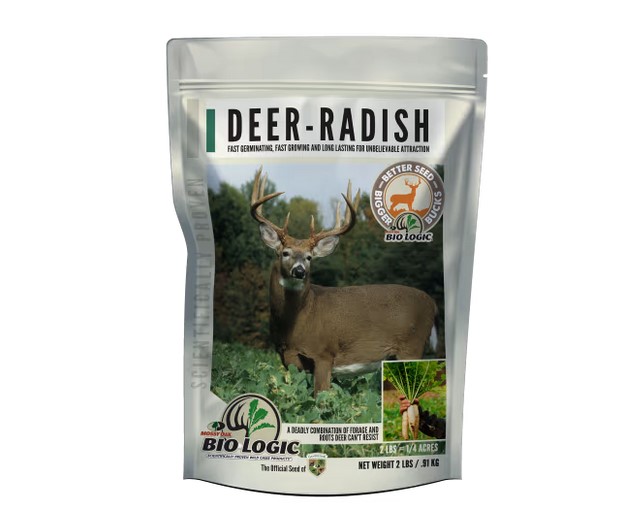
When it comes to late-season deer attraction, the Mossy Oak Biologic Deer Radish stands out. This specific product is highly desirable for deer due to its highly nutritious forage and sweet roots, attributes that deer crave, and it is 100-percent consumable for a start-to-finish attraction scenario. As the temperature starts to dip, deer move towards the radish clusters for sustenance, creating an optimal hunting scenario.
To get the maximum attraction in the late season, you can plant Deer Radish from late summer to early fall at a rate of two pounds to one-fourth of an acre. The Deer Radish will then grow in a variety of soil types, given there is adequate soil moisture. Remember, you can also plant it by itself or with other seed blends for early-season attraction, even if it works best as a late-season alternative. While it can add significant hunting value to small plots, it requires frequent crop rotation and may not be the most attractive option for early-season.
This radish-based product reaffirms one thing: that a good food plot is a surefire way to keep deer coming back to your property. The Mossy Oak Biologic Deer Radish is an excellent choice for late-season deer hunting and enhancing your food plot program.
Best for the Midwest: Mossy Oak Biologic New Zealand Maximum
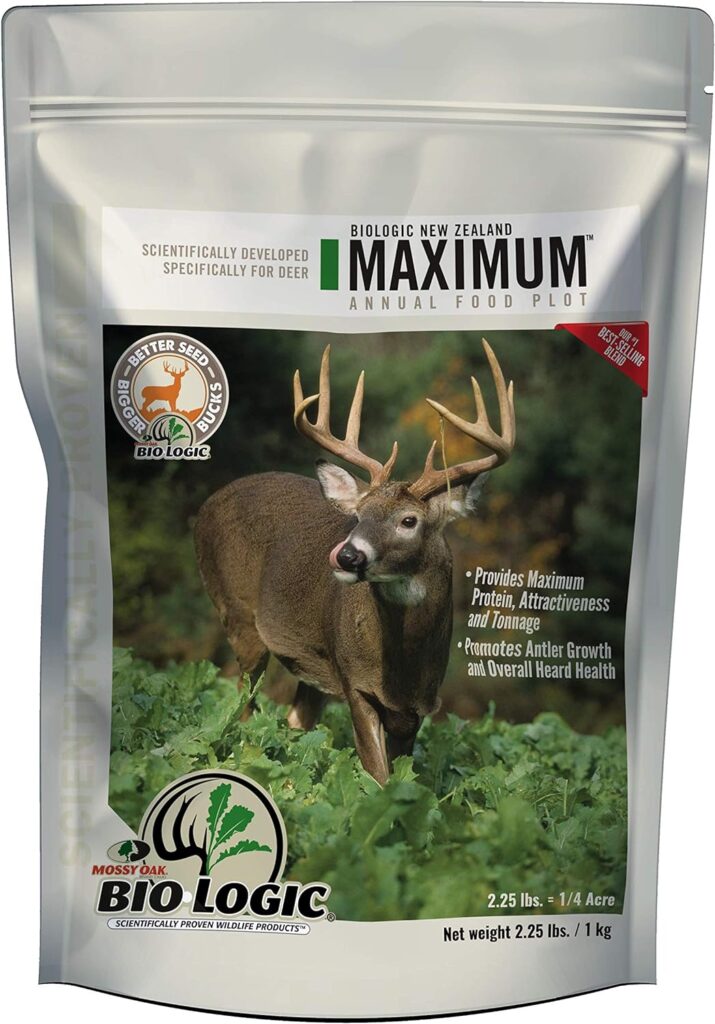
The Mossy Oak Biologic New Zealand Maximum is the top pick for those hunting in the distinctive Midwest region. This product is a blend of New Zealand Red and White clovers and chicory, specially designed to provide the maximum amount of forage possible in a food plot product.
The New Zealand Maximum grows well in a wide variety of soil types, and its hardiness allows it to thrive in the challenging climatic conditions of the Midwest. The blend’s offering is high in protein and minerals essential for antler and body growth, enticing deer to frequent the plots. The blend also offers bloom sequences to give the plot palatability from summer to fall.
However, you need to know that this blend might require more soil preparation and timely plantings. Therefore, plan to plant this blend in spring and early summer, depending on your geographical location. Also, regular mowing keeps the blend fresh and appealing to the deer while helping it resist disease.
In conclusion, the Mossy Oak Biologic New Zealand Maximum is a top-tier food plot choice for hunters wanting a year-round attraction and maximum forage in the Midwest region. Its growth and benefits make this blend an excellent addition to food plots in this area.
Best for Fall: Whitetail Institute Imperial Clover
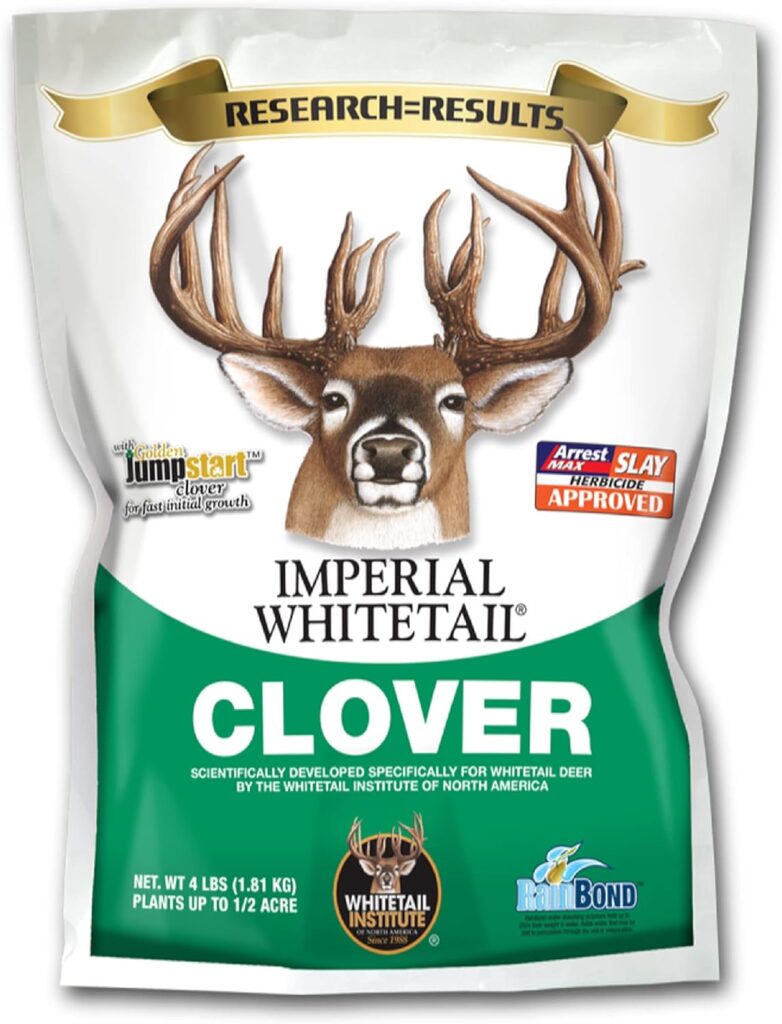
The Whitetail Institute Imperial Clover stands out when it comes to Fall food plots. This seed blend is not just another ordinary clover mix. It is the first clover specifically developed for whitetail deer and wild turkeys, and it sets the gold standard for clover production.
Imperial Whitetail Clover is packed with up to 35% of antler-building protein and includes a blend of the Institute’s patented clovers. It is extremely cold tolerant and resistant to harsh weather, and heavy grazing, ideal for withstanding the early fall frosts and snowfalls.
The Imperial Clover is also a perennial, meaning it can last up to five years from a single planting, perfect for plots that you wish to maintain long-term. It’s an excellent blend for attracting deer in the fall, and the clover is also palatable, keeping deer coming back for more. Since the blend will remain green into late Winter, it will give deer a vital food source when alternatives are scarce.
However, remember that this blend requires proper soil preparation and maintenance with an optimal pH of 6.0 to 7.0. As a recommendation, plant in the spring or late summer/early fall, depending on your region, to provide succulent growth throughout fall and into winter. To sum it up, Whitetail Institute Imperial Clover offers an irresistible attraction and nutrition to deer, making it an excellent choice for fall food plots.
Best No-Till: Mossy Oak Biologic Hot Spot
The Mossy Oak Biologic Hot Spot is the perfect choice for those who lack access to farming equipment. This no-till blend is specially formulated for small, remote food plots or micro-plots where using traditional farming tools isn’t feasible or areas that are hard to reach with your equipment.
The Hot Spot contains a mix of wheat, deer radish, rye, and rape. What sets it apart is its quick germination, usually within a week, allowing you to draw deer to your plot in no time. It also provides a variety of feeding options to Deer, increasing its attractiveness.
To plant Hot Spot, you only need to clear the ground using a rake and ensure good seed-to-soil contact. It is recommended to plant Hot Spot in late summer to early fall at a rate of five pounds to one-fourth of an acre. This simplicity and ease of planting make this blend an outstanding last-minute option, but it might not last as long as other types of food plots.
In conclusion, simplicity and fast yield are king when it comes to no-till plots, and the Mossy Oak Biologic Hot Spot delivers just that. It’s a fantastic choice that provides maximum results with minimum effort—perfect for the DIY deer manager or the hunter looking for a fast and easy way to attract Deer.
Best for the South: Whitetail Institute PowerPlant
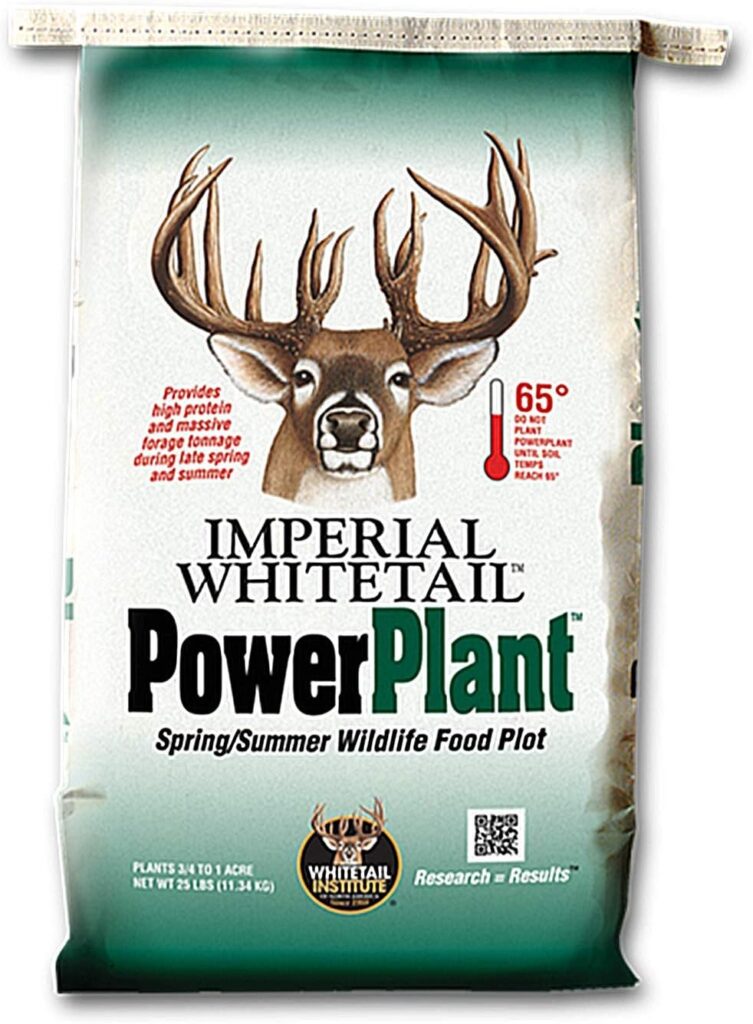
Regarding the southern regions, the Whitetail Institute’s PowerPlant earns the rank as the go-to food plot option. The PowerPlant mix primarily consists of soybeans and peas, both of which provide high protein levels to deer during the long spring and summer months—the growth period for antler formation and fawn development. It also contains sunflowers and small amounts of sun hemp, which provide vertical structure for the plot and excellent cover for deer.
PowerPlant is capable of handling heavy grazing and continues to grow as deer feed on it, making it durable and lasting. It can also tolerate the warmer temperatures of the South and usually grows well even with minimal moisture, a common condition in many Southern areas.
However, the PowerPlant food plot requires some considerations. It’s advisable to plant PowerPlant in late spring to early summer at a rate of 25 pounds on one acre. Also, PowerPlant may call for more extensive soil preparation and a larger acreage to be effective compared to other products.
In summary, the Whitetail Institute’s PowerPlant is a top choice for southern regions due to its hardiness in hot climates and its ability to provide ample protein for deer during the critical growth period, making it an excellent choice for your southern hunting property.
Things to Consider Before Planting a Food Plot
Understanding Soil Quality in Food Plots
Understanding soil quality is crucial when planning your food plots as it can influence the success of your plot. Typically, factors like soil pH, fertility, and moisture will determine the success of your plantings.
The optimal soil pH for most food plot crops is between 6.0 and 7.0. A lower pH value may prevent your plants from utilizing available nutrients effectively, contributing to less vigorous growth of the crop. Improving soil pH can be labor-intensive, requiring the spreading of lime, but with the right approach, this can be managed successfully.
Soil fertility, or the availability of essential nutrients in the soil, is another important aspect. It’s common to find low fertility levels in areas that have not been previously cultivated, and this can be improved with a good fertilization regimen.
Last, but not least, soil moisture levels play a pivotal role. The timing of your plantings can impact whether your plot will have adequate moisture for germination and growth. Planting towards the end of a dry spell or prior to a rain can ensure your seedlings have sufficient hydration for successful growth. Remember, maintaining a balance between all these factors can set your food plots up for success.
Considering Seasonal Variations and Geographic Location
Considering seasonal variations and your plot’s geographic location is paramount in determining the right food plot seed to plant. The success of your food plot depends heavily on the climatic conditions of the region it’s planted in and the time of the year.
Different crops thrive during various seasons. For example, brassicas and turnips are more suited for late summer to early fall plantings, attracting deer during the late hunting period. Some seeds, like clover or alfalfa, are frost tolerant and can provide a consistent food source into early winter. On the other hand, soybeans and peas are high in protein, an essential nutrient for deer during the spring and summer – the antler growing season.
Geographically, certain crops do better in specific regions. Warm-season crops like the PowerPlant blend work well in the South, which tends to have longer, hotter growing seasons. In contrast, the New Zealand Maximum blend might be more suitable for the Midwest areas, where the soil and climate are less predictable.
While the success of your food plot is contingent on several other factors like soil quality, sunlight exposure, and browsing pressure, considering seasonal variations and geographic location should be in your strategy. By taking them into account, you can create a food plot that successfully attracts and nourishes deer all year round.
Reviews on Popular Food Plot Brands
Review on Mossy Oak Brand
Mossy Oak Brand has established itself as a leading food plot brand in the hunting industry. One of its distinguishing features is its use of scientifically researched blends of seeds that attract and nourish game animals all year round.
The buck stops at their extensive product range suitable for various seasons and geographical locations. Some of their stars include the Deers Radish – perfect for late-season attraction, the New Zealand Maximum – designed for temperamental Midwest conditions, and the Hot Spot blend – an excellent no-till choice that’s ideal for small, difficult-to-reach areas.
While their blends cater to a wide range of conditions, they’re not ‘plant and forget’ solutions. Some require optimum soil conditions and regular maintenance to thrive. Despite this, Mossy Oak Brand products are generally easy to grow and yield fast, making them a preferred choice for many wildlife managers and hunters alike.
In conclusion, Mossy Oak Brand offers a combination of seed diversity, scientific research, and easy-to-grow options. It remains a top choice among hunters and wildlife game managers, standing tall as a reputable brand in the hunting community.
In-depth Analysis of the Whitetail Institute Seeds
Consistently recognized for developing high-performance blends, Whitetail Institute’s seed line has a great reputation in the hunting community. At the core of the Institute’s success is the unwavering commitment to scientific research behind their seed blends. They ensure each blend, from Imperial Whitetail Clover to PowerPlant, is specially developed to cater to the specific nutritional needs of the whitetail deer.
The Imperial Whitetail Clover, their flagship product, is a noteworthy blend that stands the test of time. The only clover genetically designed for whitetail deer, it offers nutrient-dense perennial that can last up to five years from a single planting. It’s an extensive choice from late summer to early winter.
Equally excellent is the PowerPlant blend, specifically designed for the warmer climates of the South and pivotal in providing essential nutrients in the high antler growth period.
That said, the Whitetail Institute’s seeds aren’t without their challenges. Most blends require proper soil preparation and lean towards larger plots. Also, the success of some of the plantings might require time, making them less ideal for hunters requiring immediate outcomes.
In summary, the Whitetail Institute delivers products designed with the deer’s and hunters’ needs in mind. It is a frontrunner in the food plot seed industry, making it a top choice for anyone serious about deer hunting and management.
Conclusion: Final Thoughts on Selecting the Best Food Plot
How You Can Benefit from Choosing the Right Seed
Choosing the right seed blend for your food plot can yield several benefits. First, it ensures you attract and hold deer on your land all year round, significantly improving your hunting yield. Increased attraction can also translate to better observations of the deer herd, enhancing your hunting strategy.
Secondly, the right seed blend improves the health of your deer herd. A well-planted food plot supplies nutrient-rich feed, fostering body and antler growth, ensuring healthy fawns, and significantly improving the overall health of the herd throughout the year.
Lastly, a well-chosen seed blend contributes to successful land and wildlife management practices, enhancing your property’s value by creating a sustainable wildlife habitat.
In conclusion, the reward of a successful food plot stretches beyond hunting. The right seed blend leads to improved deer health, a better hunting experience, and enhanced property value due to effective wildlife management practices. It’s a win-win situation for both the hunter and the deer.
What’s Next After Finding the Perfect Seed?
Once you’ve found the perfect seed blend for your food plot, it’s time to move on to the next steps of site preparation, planting, and maintenance. Your soil should be prepared properly to ensure successful germination and growth. This usually involves testing the soil pH, adding necessary soil amendments, and tilling the soil to create a good seedbed.
After soil preparation, your seeds can be spread according to the recommended seeding rate and depth for the blend. Then ensure good seed-to-soil contact, either through light raking or using a roller or cultipacker.
Once planted, maintain the plot by keeping it free from competitive plant species, typically by regular mowing or spraying with a relevant herbicide. Some blends may also need additional fertilizer throughout the growing season.
Well-maintained plots can last several years, attracting and nourishing deer season after season. After all, the goal is to create a food plot that lets you enjoy the fruits of your labor while enhancing the health and population of your deer herd.
FAQs
What is the Best Time to Plant a Food Plot?
The best time to plant a food plot depends on the type of seeds you choose and the regional climate conditions. Typically, spring and late summer are common times to plant perennials such as clover. They need time to establish themselves and become hardy enough to withstand the winter.
If you’re planting brassicas or other species used largely for autumn deer attraction and hunting plots, late summer is usually the best time. They provide lush, nutritious forage that persists after many other plants have succumbed to frost and cold weather.
Remember, it’s always crucial to watch the weather and consider the needs of the specific seed blend you’re planting. Some seeds require warm wet soil to germinate, others need cooler conditions. Always refer to the planting instructions on the seed bag for the best results.
Which Brand Offers the Best Food Plot Seed?
Determining the best brand of food plot seed can be subjective as it depends on a variety of factors such as the local climate, soil conditions, the specific needs of local wildlife, and personal experience. However, prominent brands such as Mossy Oak and Whitetail Institute are recognized for their high-quality seed blends.
Mossy Oak offers a wide range of scientifically researched seed blends suitable for various seasons and geographical locations. The brand is widely known for its products’ high germination rate and plants’ durability under heavy grazing.
The Whitetail Institute, likewise, offers a diverse array of seed blends scientifically designed to meet the specific nutritional needs of whitetail deer. Renowned for products like the Imperial Whitetail Clover and PowerPlant blends, the Whitetail Institute has gained a reputation for the year-round attraction, high protein content, and long lifespan of their plots.
In conclusion, the best brand ultimately depends on your specific scenario and requirements. Always take your unique conditions into account and use a brand that consistently delivers results given your specific hunting situation.


